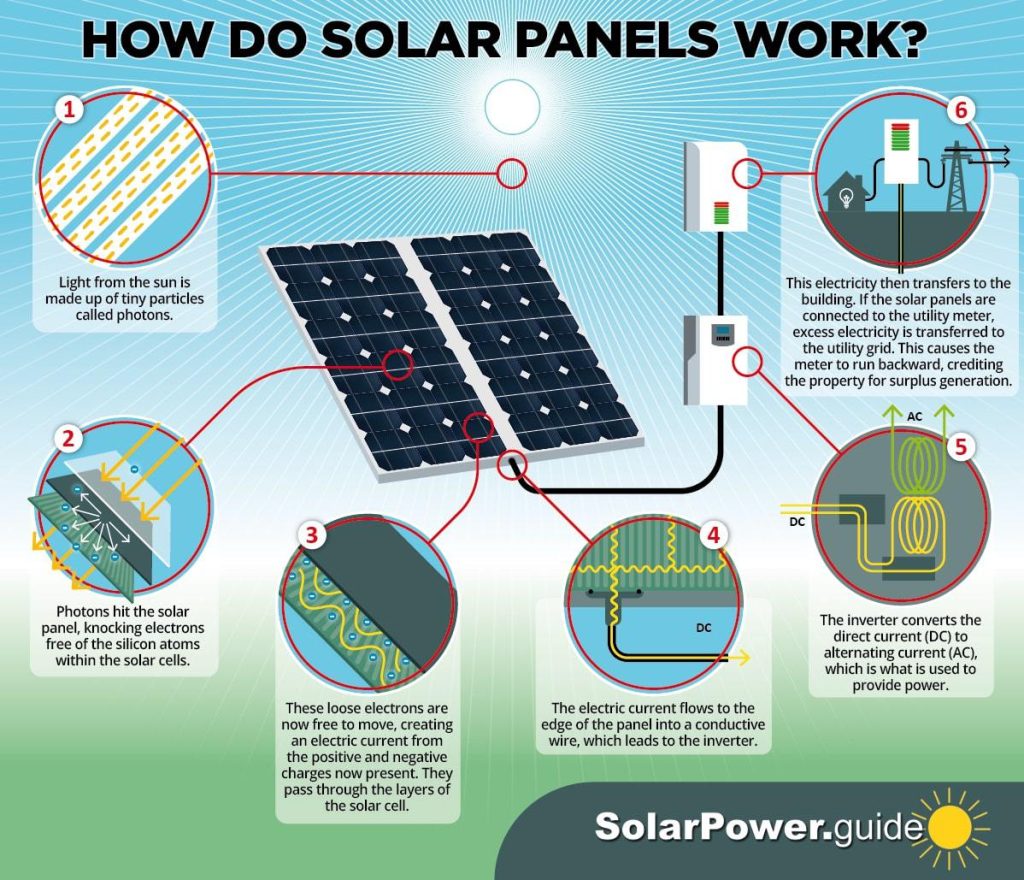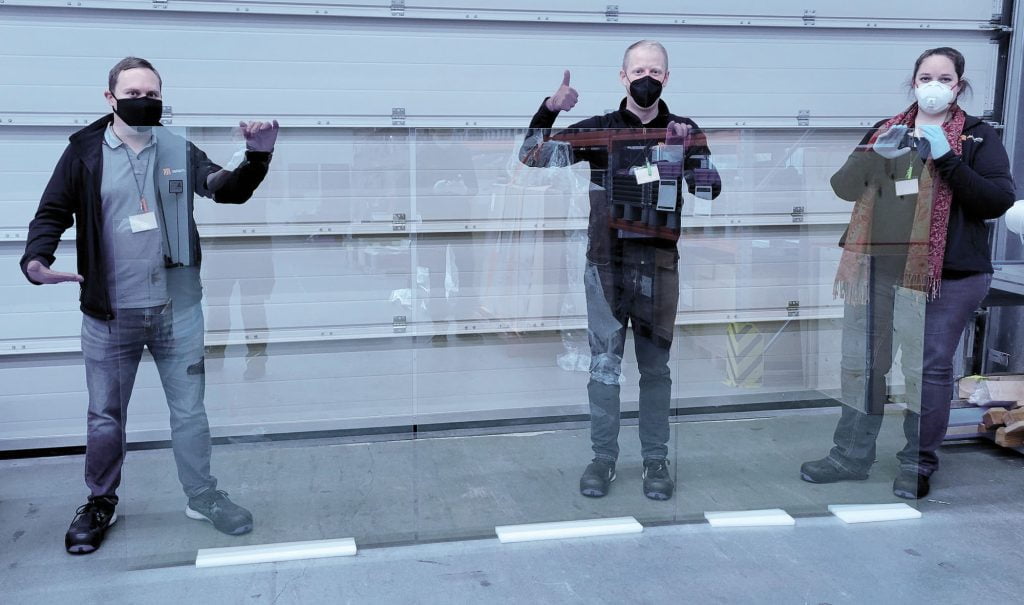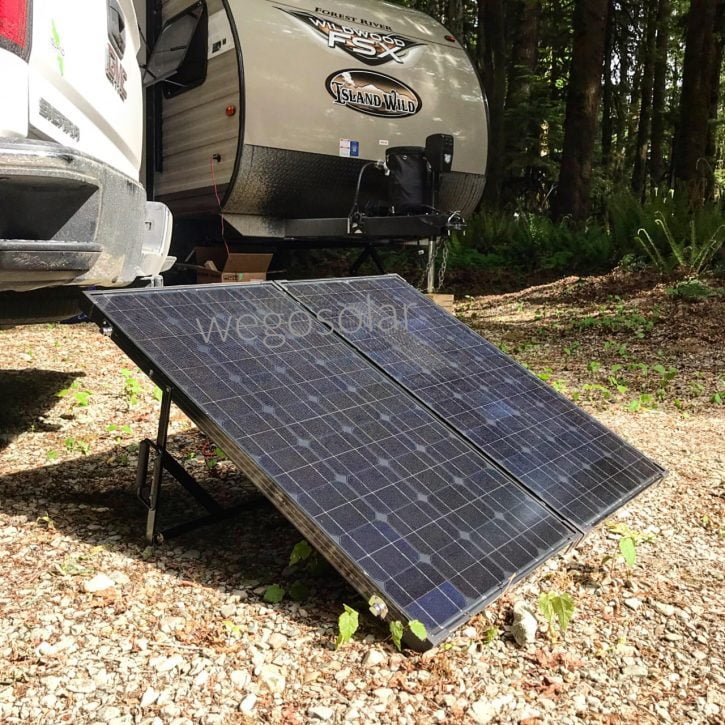The best part about solar energy is that it’s free; however, collecting it is different. Solar energy is particularly interesting to RVers, as our energy needs are greatest when off-grid. With solar, we can store power in house batteries, power from generators, or be plugged into shore power. Solar is the ideal solution with no noise, no plug-ins, and no need for batteries that run out of power.
However, a certain level of understanding of this technology is required. Some people may shy away from solar because harnessing it can be difficult. But with a better understanding of the technology, we can all benefit from the sun’s powerful UV light. Here is a visual of a solar panel and an explanation of what solar power is and how it’s gathered.

How do solar panels work?
This photovoltaic effect, the process by which the sun’s rays are converted into electrical current, was discovered back in 1839 by French physicist Edmond Becquerel. Still, it wasn’t until the 1950s that the first modern silicon-based solar cells were demonstrated at Bell Labs. Since then, the race to make solar energy more efficient and less expensive has been underway, and progress has been dramatic. In the past ten years alone, the cost per kilowatt of solar energy has fallen from nearly $2 to about 34 cents.
However, research continues. Some scientists are even questioning the foundational material of solar panels— silicon—and experimenting with organic photovoltaics and perovskite solar cells. This would replace silicon with more widely available compounds for cheaper manufacturing, and quantum solar cells made of microscopic semiconductor particles can more efficiently harvest the sun’s energy. These so-called third-generation photovoltaic cells may overcome the efficiency limits of contemporary solar, pointing to a future in which the energy is more affordable up front—and looks radically different from the rigid blue panels we’ve grown accustomed to. (Text courtesy UBIQUITOUS ENERGY)
As you can see in the photo, this new solar panel is clear – and may one day double as a window.

UE-Power Large Area Demo
What else should you know about solar panels?
Top of mind – the cost.
- A permanent 400 Watt install of ridged panels (four of them) on an RV rooftop with the wiring, controls and batteries will run around $1000 if you do it yourself.
Now comes the question – as an RVer – do you need solar panels?
- If you travel from hookup to hookup – the answer is no.
- If you spend the odd night dry camping, your house batteries should attend to all your needs. You don’t need solar panels.
- If you spend days dry camping, solar is the answer and a much quieter one than a generator. /li>
How about usage? You need to know how much electricity you are consuming.
As an example:
- First – don’t concern yourself with Amps and Voltage – at this stage, Watts are all you need to calculate energy needs.
- When we describe a light bulb as 100 Watts, we describe how much energy it uses each hour.
- The same is true for appliances. Most every appliance has a sticker showing what its Watt usage is. Whatever the number is, it describes how much power it needs to run for one hour.
- With a bit of math, you can determine what your typical daily usage will be.
- However, the best way to tell how much electricity you use from a house battery is by measuring consumption using a shunt-based battery monitor. This can be added long before you buy solar panels so you can see your Watt usage – then you can buy what’s appropriate.
Two terms you need to know.
- Converter – converts any generated power (solar or generator) to DC (direct current), which you store in your house batteries.
- Inverter – converts that DC power to AC (alternating current), which is needed to run almost all your onboard appliances.
Some background on batteries – they are not all the same.
- Sealed lead-acid batteries are not good for solar storage. The electrolyte in a flooded, sealed lead acid battery will disappear after the warranty expires.
- Flooded lead-acid deep cycle batteries with refill caps can be good; you can add distilled water as needed.
- Lead-acid batteries also degrade solar panel performance because they resist being charged.
- Batteries made from lithium iron phosphate are the best deep-cycle batteries. They have a much longer life span and are the least expensive batteries you can buy when judged on life cycle costs — but they cost more upfront.
Basic information about Solar panels and controllers.
- Solar panels should last 20 years. Some of the least expensive solar panels will only last a few years. Why? Solar cells are extremely thin and do not tolerate vibration well. So, the framing and installation are important.
- Price is a good indicator of longevity. Look at RV solar panels with a good warranty from a company that has been doing business for a long time.
- RV solar controllers are another place where installers try to cut costs. A good way to judge a controller is by its weight. It should be heavy. It should not have a fan. Fans fail, and then the controller will overheat and die. A good controller has an aluminum heat sink that won’t fail.
- Portable RV solar panels have a huge advantage over fixed solar panels because you can point them at the sun. You can even track the sun as the day progresses to get more energy from them than fixed panels ever could produce.
- The minimum wire size for any solar panel installation should be ten gauges. Some locations may require wires as thick as four gauges.
What kind of performance can you expect?
- Fixed solar panels often have a less-than-ideal orientation to the Sun. So, if the panel says 100-watt output, you can count on about 70 watts of usable power per hour during the peak exposure hours, which is about five hours per day, even in the winter. Summer will give you about two extra hours. Don’t calculate a 100-watt panel to produce 500-watt/hours of energy each day.
- Overcast and shade can cut the performance of a solar panel by 90%.
Today, most new RVs are already wired to accept solar panels – and many come with solar panels installed. As time goes on, this will become the norm. RVs are already set up with solar panels, batteries and controls from the factory. For instance, I ran across this news release from Volta Power Systems describing this collaboration with a Class B manufacturer.




